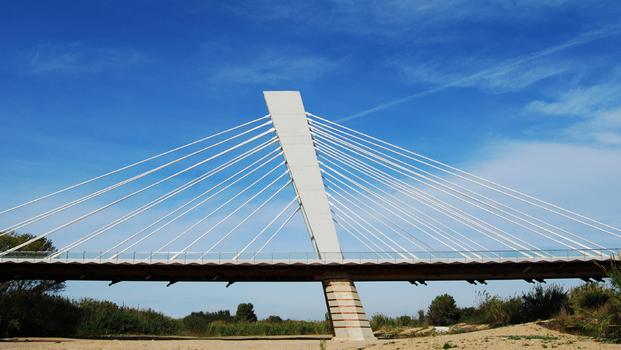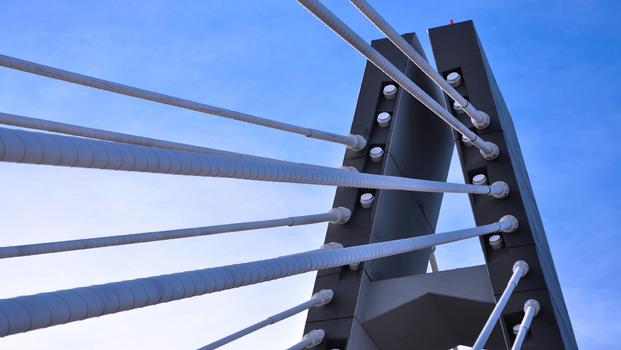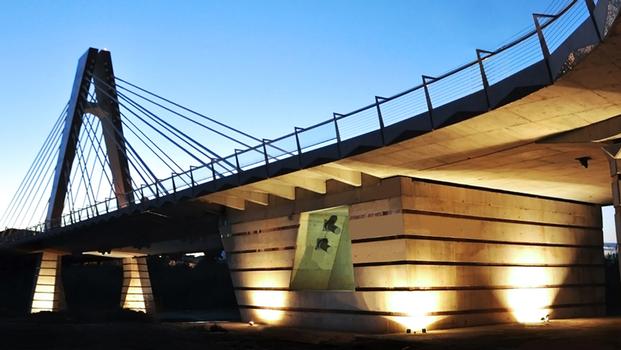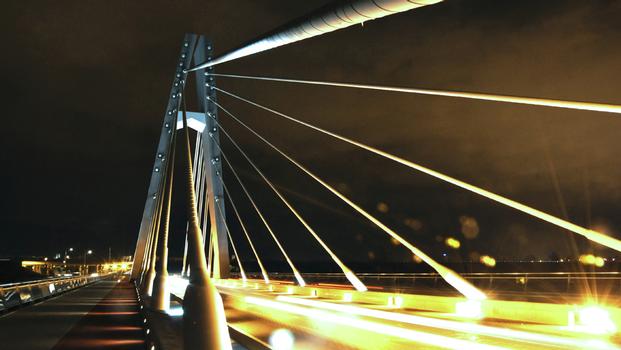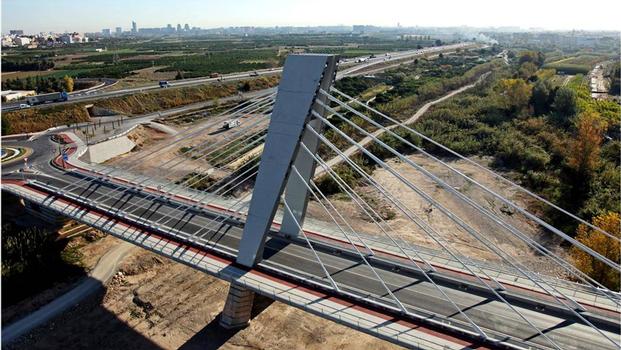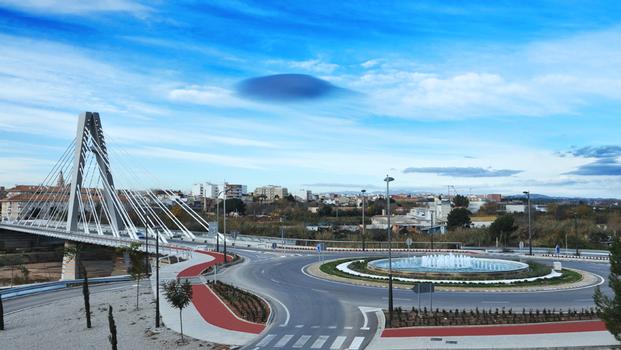General Information
| Name in local language: | Puente de Paterna-Manises |
|---|---|
| Beginning of works: | 2007 |
| Completion: | 2009 |
| Status: | in use |
Project Type
| Function / usage: |
Road bridge |
|---|---|
| Structure: |
Cable-stayed bridge with semi-fan system |
| Material: |
Steel-reinforced concrete composite bridge |
| Secondary structure(s): |
Structurae Plus/Pro - Subscribe Now! |
| Material: |
Structurae Plus/Pro - Subscribe Now! |
| Secondary structure(s): |
Structurae Plus/Pro - Subscribe Now! |
Location
| Location: |
Manises, Valencia, Valencia, Spain Paterna, Valencia, Valencia, Spain |
|---|---|
| Address: | CV-371 |
| Crosses: |
|
| Coordinates: | 39° 29' 35.92" N 0° 27' 6.98" W |
Technical Information
Dimensions
| main span | 90 m | |
| width | 22.4 m | |
| total length | 180 m | |
| pylon | total height | 42 m |
| pylon height (above deck) | 31 m |
Materials
| pylon |
reinforced concrete
|
|---|---|
| piles |
reinforced concrete
|
| deck slab |
reinforced concrete
|
| abutments |
reinforced concrete
|
| girders |
weathering steel
|
Chronology
| April 2009 | Inauguration. |
|---|
Notes
Up to 1 250 m³ of concrete used in the construction of the bridge were recycled from the demolition of the previous structure. The structure is a pilot project for the usage of recycled aggregate in a cable-stayed bridge. The recycled concrete technical specifications, process supervision and quality control design was carried on by Pilar Alaejos and Marta Sánchez of CEDEX (Centro de Experimentacion de Obras Públicas, Ministerio de Fomento, Spain)
The pylon was erected by means of a climbing formwork. The deck was built on shoring stays were tensioned after completion of the deck.
The project includes the construction of a new boulevard between Manises and Paterna and a new bridge over the river Turia. The bridge is the main element of this intervention thanks to its magnificent presence and the contribution of the construction process. The geometry solves traffic hydrological requirements efficiently and creates a great gate to towns over the river Turia.
The new cable stayed bridge reduces the obstacles inside the riverbed, raises the elevation of the deck by 4 m and represents a formally attractive engineering solution. The form of the pylon is inspired in a sort of knife sticked into the earth; weight of the deck is transferred through the cables. The idea of using some traditional material (tiling of horizontal strips) was found to be attractive for the lower part of the bridge.
The construction of the new bridge required the demolition of the preexisting structure. The authors proposed recycle it as raw material in the production process of the concrete for the new elements, mainly deck and pillars. CMD received support of Cedex, a Spanish scientific institution on civil and structural engineering, to develop the recycling and construction process.
Participants
-
CMD Domingo y Lázaro Ingenieros SL
- Carlos Lázaro Fernández (structural engineer)
- Alberto Domingo Cabo (structural engineer)
- CMD Domingo y Lázaro Ingenieros SL
- Francisco Palacios (structural engineer)
- Salvador Monleón Cremades (structural engineer)
Relevant Web Sites
There currently are no relevant websites listed.
Relevant Publications
- (2008): Aspectos especiales del control de calidad del hormigón reciclado utilizado en el puente atirantado sobre el rio Turia en Manises (Valencia). Presented at: IV Congreso de la Asociación Científico-Tecnica del Hormigón Estructural - Congreso Internacional de Estructuras, Valencia, 24-27.11.2008.
- (2011): Bridges at the Edge of Town: Recent Experiences. Presented at: 35th Annual Symposium of IABSE / 52nd Annual Symposium of IASS / 6th International Conference on Space Structures: Taller, Longer, Lighter - Meeting growing demand with limited resources, London, United Kingdom, September 2011.
- (2009): Construction of a cable-stayed bridge with recycled concrete in Valencia (Spain). Presented at: 2nd International RILEM Conference: Progress of Recycling in the Built Environment, Sao Paulo, 2009.
- DSC liefert Schrägseilsysteme für Spaniens umweltfreundlichste Brücke. In: DSI Info, n. 17 ( 2009- 2010), pp. 36.
- (2005): Puente reciclado sobre el río Turia en Manises (Valencia). Presented at: Las Estructuras del Siglo XXI III Congreso de ACHE, Zaragoza, 2005.
- About this
data sheet - Structure-ID
20048239 - Published on:
24/09/2009 - Last updated on:
16/10/2017

